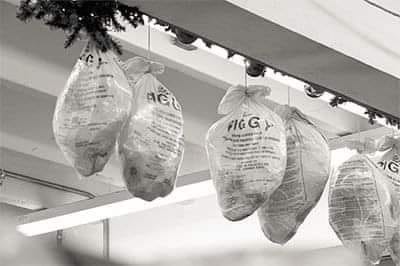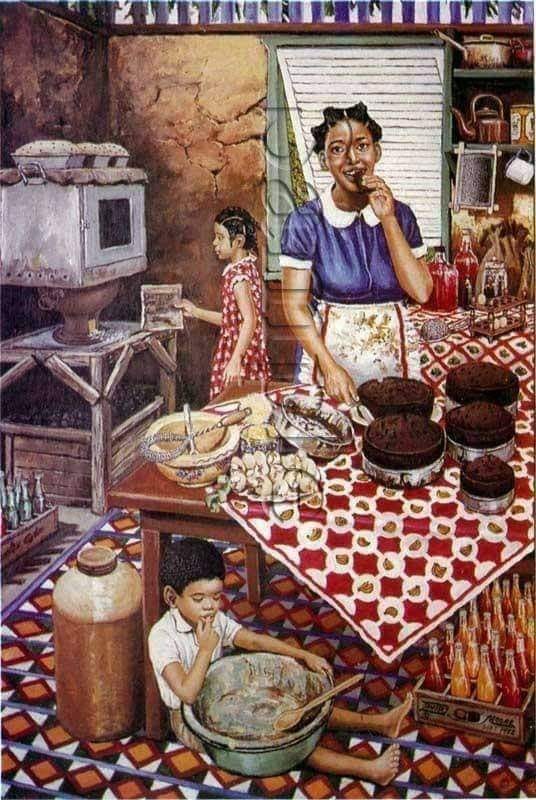|
From Tar Hams to Salt Butter
...PoS grocery takes shoppers back to old-time days Credit to Author : Charles Kong Soo Sing Chong Supermarket on Charlotte Street, Port-of-Spain, is a modern supermarket, but shoppers can feel as if they stepped through a time warp to the old-time days of Chinese shopkeepers and parlours on the village corner.In one section of the supermarket you can find loose salt butter, table margarine, lard and peanut butter packed neatly in white wrapping paper just like in "Mr Chin's" shop from a bygone era. The culinary treasure that attracts foodies and tantalises the taste buds of the golden generation alike, however, is the tar ham hanging from the ceiling. This is the same type of ham granny and grandpa used to boil in a biscuit tin over a wood fire or pitch-oil stove in the backyard and sometimes baked after in a coalpot tin oven or mud oven. Anthony Low, the supermarket's owner, said since his father, Johnson Achong Low opened Sing Chong's in the 1940s they were importing premium tar hams or soak and boil hams as they were also called.He said, "Since I was 14 years old and working with my father, in those days we were bringing in Darling Downs ham from Australia and Swift's ham from the US encased in tar."Tar and Darling Downs ham got expensive, and when Government banned ham importations in the '70s it became too prohibitive. "When the market opened up in the '80s I began bringing in this brand, 'Piggy' ham every year."Low's son, Christopher, said he knew of the ham hanging from the supermarket's ceiling since he was small.He said when the distributor was no longer importing salt hams, the supermarket decided to source it for itself.Christopher said there were not many other supermarkets selling the traditional hams. Low said not everyone had a fridge in the early days, that the ham didn't need refrigeration, and it could last for three years with just some loss in weight.He said even when it was cooked, the ham could be left outside covered and it wouldn't spoil.Low said people started using big pots to cook their hams in when they became available, and the unique smell given off by the ham cooking in the yard wafting in the open air could be detected by neighbours a great distance away. He said he kept at least 12 hams for himself and boils one every month to share with his family, friends and employees, and it goes very fast.Low said a customer bought a soak and boil ham and returned it on Christmas eve 2012 "burnt like charcoal," asking him if he knew how to cook it.The man said his mother had died and she cooked the ham for his family every year when she was alive.He had never learned how to prepare the ham, and he had put it in the oven to bake. Low gave the man the cooking instructions: soak the ham for three to four days, add lime or sugar, discard the water every day, boil for at least two hours until done, bake after if so desired, adding cloves and pine for a different flavour.He gave the man a replacement ham. The man returned to him after Boxing Day to say thanks as it came out "perfectly" like his mother's.Low's plan is to ask the manufacturers to place cooking instructions with the hams in the next shipment. __________________________________________ According to Historian Angelo Bissessarsingh tar hams were made locally in the South-West peninsula from the '30s up to the early '50s Source: Virtual Museum of TT, Dec 24, 2021
0 Comments
Arima-born author Neil Bissoondath was today appointed to the Order of Canada by the Governor General, “For his contributions to Canadian literature through his groundbreaking examinations of multiculturalism and diversity.” Bissoondath participated in the 2014 Bocas Lit Fest in T&T and served on the panel of judges for the literary non-fiction category. Congratulations!
Michael Cherrie, an award-winning actor from Trinidad and Tobago has been cast alongside Academy-award winning actress Regina King (The Harder They Fall) in her upcoming movie SHIRLEY.
Cherrie will portray King’s husband Conrad O. Chisholm in the film produced by Participant and Regina King’s Royal Ties Productions. Regina King will star as Shirley Chisholm in the film written and directed by Academy-Award winner John Ridley (12 Years a Slave, Guerrilla, Let It Fall: Los Angeles 1982-1992). SHIRLEY is the intimate portrayal of trailblazing political icon Shirley Chisholm, who was born to a Barbadian family and was the first Black Congresswoman and the first Black woman to run for President of the US, and the cost of accomplishment for Shirley herself. This film will tell the story of Chisholm's boundary-breaking and historic presidential campaign, based on exclusive and extensive conversations with family, friends and those who knew her best. Labelled the Black Brando for his performance in Britain’s Channel 4 television production of Kittitian-born Caryl Phillips’ The Final Passage in 1996, Cherrie is a Cacique-award winning actor who has appeared in numerous theatrical and film productions in T&T and the USA. His theatre credits in the United States include:
Commenting on his casting in the Netflix-bound production, Question Mark’s founders Simon Baptiste and Carolyn Pasea said: “Question Mark has always taken pride in managing extraordinary talent. Michael's body of work and dedication to his craft, certainly speaks volumes, but his integrity and character is what makes him stand out, and the major reason why we wanted to represent him. Michael is a good soul who wants to see everyone succeed, and that drives us to work harder on his behalf each and every day.” Cherrie will act alongside a cast that also includes Lance Reddick (John Wick 1-4), Lucas Hedges (Manchester by the Sea), Christina Jackson (Swagger), Dorian Missick (For Life), Amirah Vann (Underground), W. Earl Brown (Deadwood), with André Holland (Passing) and Terrence Howard (Empire). Participant will be focusing its impact work tied to SHIRLEY around the company’s ongoing dedication to advancing civic engagement and social justice. SHIRLEY will air on Netflix at a date to be announced. (Source: the Loop, Dec. 15, 2021) While parang music is being played in the background, Trinidadian kitchens will be busy making pastelles during the holiday season.
Pastelles are a Caribbean dish similar to tamales and are traditionally made at this time of the year, says Arielle Neils, executive chef with Kitchener, Ont.'s the Compass Group, including in her home. "It's said that they are a very old dish coming from Spanish influence," Neils says of the Trinidadian version she loves to prepare. "Making them brings me back to being in the kitchen with my mother and grandmother at Christmas time." Beef or chicken is sautéed with capers, olives, raisins and other aromatics, which are then stuffed into a pocket of corn flour dough and wrapped and steamed in a banana leaf. "It's important to note that we use corn flour, not cornmeal," Neils said. Grandmother taught her to cookShe has been making pastelles since she was seven years old in Chaguanas in central Trinidad, helping her grandmother, who was a chef and caterer. "My grandmother was the first person who taught me to cook. She's still with us and represents the mix of cultures that is Trinidad," Neils says. "When I was 13 years old, my grandmother took a catering job for a huge number of pastelles. It took us two days to make them all. We worked very hard and they surprised me by getting me a cellphone when we were done." Learning to cook at a grandmother's elbow is a common memory shared by many chefs. From a dough-making perspective, Neils learned the importance of touch and feel — how a successful pastelle dough must be pliant and malleable. "My grandmother taught me to squeeze the dough and if a crack forms, it needs more liquid because it is too dry." Typically eaten close to Christmas Day, pastelles seem to inspire people to assemble them much earlier, according to Neils. "I was looking on Facebook in November and people have already started making and eating pastelles." 'Heart, passion and love' go into pastellesThe process isn't necessarily difficult, but there are several steps so Neils advises getting all your ingredients ready and waiting before starting to cook. While some cooks boil pastelles, she prefers to steam them for a better texture. She said you can omit the butter and meat in the ingredients and use lentils for vegan pastelles. Neils recommends visiting Latin and West Indian grocery stores for supplies such as green seasoning and banana leaves. "As for the Scotch bonnets, if you don't like too much heat, remove the seeds and membrane, or leave them out all together," she said. The tactile act of working the dough and folding it into banana leaves also stirs memories of childhood for Neils. "Making pastelles, I start to feel warm inside. There is heart, passion and love that goes into making them," she said, adding it's important for her to pass along the tradition to her son. "Pastelles … bring me fond memories of working in the kitchen with my mother and grandmother; they feed the soul and create happiness and fulfilment. "They are the ultimate Christmas food in my culture." Beef pastelles by chef Arielle NeilsIngredients For the dough:
Marinate ground beef with green seasoning and refrigerate, preferably overnight. Add marinated ground beef to a hot pan and cook for six minutes or until meat is browned. Add onions, celery and garlic, sauté for three minutes, then add pimento peppers, olives, capers, Worcestershire, annatto, raisins, salt and pepper. Sauté until peppers and raisins have softened and any liquid has evaporated (about four to five minutes). Turn off heat and add green onions and Italian parsley, then set aside to cool. In a medium bowl add warm water and butter. In another medium bowl add corn flour, beef bouillon and sugar (pinch of salt and pepper is optional). Once butter is melted in water, begin adding the water mix little by little to the corn flour until dough comes together and is very soft. Divide the dough into six roughly equal parts. Wash and dry your hands and then rub your palms together with oil. Spoon the dough into your oiled hands and shape into a ball, one by one; they don't need to be perfect spheres. Cover the dough balls with a wet towel and set aside. Add water to a pot or steamer, place on medium-high heat and allow water to come to a boil. A colander over a pot of boiling water also works well. Cut seven pieces of banana leaf and use a brush to oil the flat side of the banana leaf. Method for banana-leaf wrappers: Ensure banana leaf is on a flat surface and place dough in the middle of the greased side of the banana leaf; cover with another piece of banana leaf, greased side down to touch the dough then press dough to open up (it doesn't have to be a perfect circle). If using a tortilla press, follow the same method and continue with all the dough balls. Feel free to stack them in the press. Add cooked meat to the middle of the opened up pastelle dough. Gently fold the leaves in two opposite sides, one at a time over the filling, then fold in the remaining two ends to enclose the pastelle. If boiling, cut pieces of butcher's twine and tie around the pastelle in the banana leaves so they don't open when boiling. If steaming, skip this step as you can steam seam side down. Steam or boil for 15 to 20 minutes then remove from heat and allow to cool for five minutes in a colander. Unfold, eat and enjoy! These can be refrigerated for up to four days or frozen for up to three months then steamed or boiled as you go. If steaming before freezing, they can be reheated (two at a time) in a microwave with a small bowl of water beside them. Source: CBC News, Dec 11, 2021 From Historian and Author : Angelo Bissessarsingh
For most Trinidadians, no Christmas season would be complete without a shopping trip to take advantage of bargains, window-shop and to savour the whirl and rush of humanity occasioned by the hectic Christmas atmosphere. The hams have begun to put in appearances in the supermarket freezers, and the ruddy hue of sorrel on the wooden trestles of roadside hucksters. Demijohns of ginger ale have begun to grace windowsills for fermentation, and notwithstanding the astronomical price of the raw material, most assuredly will give a sharp bite to those who dare to partake of the aged vintage. Errant bakers of the domestic kitchens are sampling with gusto the rum-drenched dried fruit which have been soaking since the middle of June and which will soon form an integral part of an aromatic fruit cake. Toys which range from the simple trinkets of a bygone era to complex mechanisms with embedded microchips have commenced their temptation of young desires who fervently hope that Santa will bestow upon them, the rewards of a year of good behavior. Amidst the thick air of anticipation and festivity it would not be amiss to take a retrospective look at local Christmases of yesteryear. Almost every nostalgic Trinidadian and Tobagonian can tell stories of the ham being boiled in a pitch-oil tin, the flurry of new curtains, paranderos and the joyous tedium of pastelles on the make, but I intend to take a more historically systematic view when looking at the Trini Christmases Past. With the advent of East Indian labourers on the sugar and (to a lesser extent) cocoa estates of the island after 1845, Christmas took on a dimension of minor importance. Mostly, the labourers were Hindus and Muslims and therefore did not celebrate Christmas. Admittedly, some aspects of the field slave Christmas still survived as 19th century accounts tell of one proprietor’s wife in Central Trinidad, Elisa DeVerteuil, sharing out an annual bonus of flour, cloth and other staples to the East Indians of Woodford Lodge Estate. The arrival of Rev. John Morton in 1868 marked the commencement of the Canadian Mission to the Indians (CMI) through the auspices of the Canadian Presbyterian Church. Under the influence to the early missionaries of the CMI, Christmas became a more regular occurrence in the predominantly Indo-Trinidadian sugar-belt communities of Central and South Trinidad. Those early CMI Christmases were simple affairs, with carols being sung (some in Hindi through the translations of the Rev. Dr. Kenneth Grant and Lal Behari) and presents in the form of decorated cards and booklets being distributed, these being sent from mission fields in Canada for the benefit of their ‘heathen’ brethren in Trinidad. Conversely, as is recorded by Sir V.S Naipaul in A House for Mr. Biswas, Indo-Trinidadian Christmas celebrations in the estate barracks comprised for the most part of a surfeit of food and grog, after which a spate of wife and child beatings would inevitably follow to cap off Christmas Day revelries. Christmas for the urban Afro-Trinidadian, particularly for those of the barrack-yards of East Port of Spain, was a more complex affair although like their East Indian contemporaries, Yuletide activities invariably involved the consumption of copious libations of spirits, sometimes with unwelcome side-effects. The seminal thesis on life in the barrack-yards published by James Cummings (Barrack-Yard Dwellers) gives an insightful window into the Christmases of these unique inner-city environments. Cummings tells of old curtains being boiled in a broth of tea-leaves to brighten the fading textiles, when new pieces could not be afforded. Crockery, which languished year-round as ornaments would be washed in anticipation of the Christmas feast, the preparation of which was a process in itself. According to Cummings, chicken, ham and beef would be prepared according to the circumstances of the families. ‘Professional’ women known as “matadores”, would be provided with money beforehand by their male ‘keepers’ and would indulge in much food and drink for the big day. The all important preparation of the fruit cake would be supervised by ‘peel men’ at local bakeries, which in fine Dickensian style, would take in the batter of the barrack-yard cakes to be baked. The peel men were sometimes tipsy from numerous shots of rum, so often the cakes met with disaster when being slipped into and out of the mud ovens with a long-handled wooden paddle known as the ‘peel’. The menfolk of the barrack-yards were not left standing in the Christmas bustle. Months beforehand, they would purchase gallons of poor-quality rum known as ‘ca-ca-poule’ to which would be added tonka beans, citrus peel and even methylated spirits to increase the mellowness and potency of the rum. A more dignified barrack-yard Xmas dinner of the 1930s is recounted in C.L.R James’ Minty Alley wherein the well-furnished table of Mrs. Rouse is graced by a quart of iced champagne, good company and the unique camaraderie of a truly Trini Christmas. A valuable glimpse of a Christmas of the white planter elite in 1911 is given by P.E.T O’Connor, whose grandfather, Gaston De Gannes was one of the last aristocratic French-Creole patriarchs of the plantation era and who presided over his stately home, La Chance, near Arima. Every Christmas, De Gannes’ large family would descend on La Chance, complete with a battery of maidservants for care of the children. O’Connor describes the Christmas morning ritual where the children were sent up to Gaston’s room to pay him their season’s compliments: ‘He would be standing in his bedroom near his huge wardrobe with its doors open, as on the inside was tacked a neatly written list of grandchildren. As we all paraded in and out with our good wishes, he would consult the list and hand out the appropriate largesse. A golden sovereign to the eldest son of each family, a half sovereign to the eldest girl and a silver crown or half-crown to the younger children’. In terms of the monetary values of the day, the golden sovereign coin was worth more than an entire year’s wages for one of the labourers on Gaston’s Cocoa Estates. O’Connor goes on to describe the breakfast of hot chocolate and bread, followed by Mass at Santa Rosa R.C Church, the day being crowned by a magnificent family dinner, graced by Bordeaux wine and French claret. In retrospect, Christmas has from the earliest period, occupied a special place in the collective consciousness of our people. Even when adversity beset the islands during two World Wars and the recessionary period of the 1980s, nothing seemed to be able to dull the inherent warmth and camaraderie of Trinbagonians which find its most apt expression during Christmastime. As the words of Susan Maicoo’s now-staple ballad most appropriately put it ‘Trini Christmas is de best". t’s easy to spot a Trinbagonian anywhere–our mannerisms and unique range of accents with their musical inflections enhance our natural inclination as storytellers and can make us stand out in a crowd.
For those who choose storytelling as their career, however, and who intend to make it internationally, it can be challenging to have to hide the characteristics that make us unique in order to assimilate. US-based Trinbagonian actor Noel Arthur, known for his guest roles on Jane the Virgin, Good Trouble and this year’s season of You, aims to celebrate these aspects of our identity by offering casting directors a more honest version of himself in his auditions. Arthur spoke with Loop News about the shift in thinking about his career and some of his upcoming projects. “I’m excited about playing characters with the Trinidadian accent, to do as many roles as possible representing the Caribbean,” he said. Arthur explained that because of his appearance, he’s been asked to do a range of accents ranging from Jamaican to Nigerian, but that these days, he’d like to put forward something a little more authentic. “I can do [the accents], but I’ve been giving them the Trinidad accent [recently],” he said. “Take it or leave it; cast me with what you heard.” Arthur’s leaning towards greater authenticity is not just linked to a desire to showcase more of his background and identity, but to his overall approach to acting, auditioning and to the business in general. Recently, the father of two has been experiencing an unprecedented visibility which he attributes to a shift in consciousness. “This has been one of the most successful booking years in my 17 years in Los Angeles,” Arthur said. He marvelled, “What a difference a year could make, to go from being a bit player to some of the things I’ve booked.” The actor said that he used the pandemic to become more intentional about his work ethic and the audition process. “There is something inside of me that made me want to make this more effortless,” he explained. The difficulties of the pandemic allowed Arthur to zone in on his attitude towards life and goal-setting, to minimise distractions. “Not to become too spiritual, but what you put out there is what you get,” he said. “[Acting] is already a challenging lifestyle; you have to have an inner determination, a focused mindset.” This introspection brought with it some realisations about how he could make the most of the restrictions to improve his auditions. “The pandemic has been a put-forward for my career,” he said, explaining that while several actors encounter “a lot of stress” from having to record self-tapes, he’d been taking advantage of being able to curate his image for casting directors. “You’re in the comfort of your home, you perfect the performance and keep it moving.” But it wasn’t just the ease of getting to redo the lines until he was happy with them that gave Arthur’s career the push that it needed. Hollywood has a history of colourism, preferring lighter-skinned actors of colour, with directors never quite sure of how to get the lighting for darker-skinned actors quite right. More recently, series like Insecure have been praised for finally getting the art of lighting darker skin tones correct. It was as simple as that. “There was not enough light on me,” he said. “My expressions can be seen more. Nothing about my acting has changed. Technically, I just put more light on my face.” Arthur said that he had never realised how crucial this was and was grateful for the “technical revelation” that allowed him to change the way he is seen at auditions. One of Arthur’s proudest moments to date was his role in PASSAGE, directed by Oscar nominee David Massey. The movie has already been screened at film festivals this year. Referred to by Arthur as an “untold...pre-diaspora story”, the film, shot in St Croix, is set in 1600s West Africa and deals with village leader Gamba (played by Arthur) who has to overcome a threat facing his people. “It’s action-packed and beautifully filmed,” he said, adding that all the crew’s department heads, along with most of the cast, are black. In addition to the fresh insight on how to present himself to casting directors, the pandemic also gave Arthur the chance to rethink what roles he would like to play moving forward and how he’d like to play them. Once a shy child, Arthur relocated to the US as a teenager and was drawn into theatre at university. As he continued to pursue acting through grad school, he found himself becoming more of a character actor than anything, but in keeping with the theme of greater authenticity, he’s begun to see things differently. Character actors usually play supporting roles that call for varying degrees of eccentricity and often play stock characters or the same type of character throughout their career. While their work usually garners much praise, there is the danger of being typecast. “In the last year, I’ve been doing a lot of introspection [and] I don’t need to disappear anymore,” he said. “I want to stand firm in who I am…[be] present as me, with my face, my voice, my thought patterns.” Arthur has indeed found more artistic and personal freedom in committing to this decision. “One of the things coming out of not hiding behind characters anymore [is that people] are seeing me on-screen for the first time as I’m seeing myself: a real whole person.” As he continues to further relax into this more truthful on-screen persona, Arthur remains enthusiastic about his Trinbagonian identity and how he can use it to influence the projects he becomes involved in. “I’m always excited to represent Trinidad and Tobago and look forward to seeing more of us from the diaspora telling our stories, not just theirs,” he said. Arthur spoke of his screenwriting friends who have been dreaming up works that feature our culture, particularly the folklore that he hopes would make it into the mainstream. Armed with expert training, years of steady work bolstered and flavoured by his roots in the Caribbean experience, Arthur gives thanks for the newfound opportunities and readily embraces what is to come. (Source: The Loop, Nov 4, 2021) |
T&T news blogThe intent of this blog is to bring some news from home and other fun items. If you enjoy what you read, please leave us a comment.. Archives
June 2025
Categories
All
|








 RSS Feed
RSS Feed